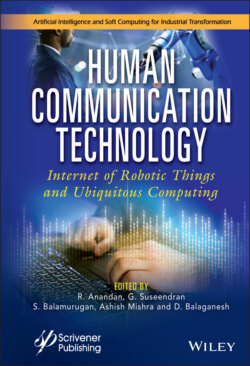Читать книгу Human Communication Technology - Группа авторов - Страница 2
Table of Contents
Оглавление1 Cover
2 Title page
3 Copyright
4 Preface
5 1 Internet of Robotic Things: A New Architecture and Platform 1.1 Introduction 1.2 Platforms 1.3 Conclusion 1.4 Future Work References
6 2 Brain–Computer Interface Using Electroencephalographic Signals for the Internet of Robotic Things 2.1 Introduction 2.2 Electroencephalography Signal Acquisition Methods 2.3 Electroencephalography Signal-Based BCI 2.4 IoRT-Based Hardware for BCI 2.5 Software Setup for IoRT 2.6 Results and Discussions 2.7 Conclusion References
7 3 Automated Verification and Validation of IoRT Systems 3.1 Introduction 3.2 Program Analysis of IoRT Applications 3.3 Formal Verification of IoRT Systems 3.4 Validation of IoRT Systems 3.5 Automated Validation References
8 4 Light Fidelity (Li-Fi) Technology: The Future Man–Machine–Machine Interaction Medium 4.1 Introduction 4.2 Literature Survey 4.3 Light Fidelity Technology 4.4 Li-Fi Applications in Real Word Scenario 4.5 Conclusion References
9 5 Healthcare Management-Predictive Analysis (IoRT) 5.1 Introduction 5.2 Related Work 5.3 Fuzzy Time Interval Sequential Pattern (FTISPAM) 5.4 Detection of Congestive Heart Failure Using Automatic Classifier 5.5 Experimental Analysis 5.6 Conclusion References
10 6 Multimodal Context-Sensitive Human Communication Interaction System Using Artificial Intelligence-Based Human-Centered Computing 6.1 Introduction 6.2 Literature Survey 6.3 Proposed Model 6.4 Experimental Results 6.5 Conclusion 6.6 Future Scope References
11 7 AI, Planning and Control Algorithms for IoRT Systems 7.1 Introduction 7.2 General Architecture of IoRT 7.3 Artificial Intelligence in IoRT Systems 7.4 Control Algorithms and Procedures for IoRT Systems 7.5 Application of IoRT in Different Fields References
12 8 Enhancements in Communication Protocols That Powered IoRT 8.1 Introduction 8.2 IoRT Communication Architecture 8.3 Bridging Robotics and IoT 8.4 Robot as a Node in IoT 8.5 Robots as Edge Device in IoT 8.6 Challenges and Research Solutions 8.7 Open Platforms for IoRT Applications 8.8 Industrial Drive for Interoperability 8.9 Conclusion References
13 9 Real Time Hazardous Gas Classification and Management System Using Artificial Neural Networks 9.1 Introduction 9.2 Existing Methodology 9.3 Proposed Methodology 9.4 Hardware & Software Requirements 9.5 Experimental Setup 9.6 Results and Discussion 9.7 Conclusion and Future Work References
14 10 Hierarchical Elitism GSO Algorithm For Pattern Recognition 10.1 Introduction 10.2 Related Works 10.3 Methodology 10.4 Experimental Setup 10.5 Discussion 10.6 Conclusion References
15 11 Multidimensional Survey of Machine Learning Application in IoT (Internet of Things) 11.1 Machine Learning—An Introduction 11.2 Internet of Things 11.3 ML in IoT 11.4 Literature Review 11.5 Different Machine Learning Algorithm 11.6 Internet of Things in Different Frameworks 11.7 Smart Cities 11.8 Smart Transportation 11.9 Application of Research 11.10 Machine Learning for IoT Security 11.11 Conclusion References
16 12 IoT-Based Bias Analysis in Acoustic Feedback Using Time-Variant Adaptive Algorithm in Hearing Aids 12.1 Introduction 12.2 Existence of Acoustic Feedback 12.3 Analysis of Acoustic Feedback 12.4 Filtering of Signals 12.5 Adaptive Algorithms 12.6 Simulation 12.7 Performance Evaluation 12.8 Conclusions References
17 13 Internet of Things Platform for Smart Farming 13.1 Introduction 13.2 History 13.3 Electronic Terminologies 13.4 IoT Cloud Architecture 13.5 Components of IoT 13.6 IoT-Based Crop Management System 13.7 Future Prospects 13.8 Conclusion References
18 14 Scrutinizing the Level of Awareness on Green Computing Practices in Combating Covid-19 at Institute of Health Science-Gaborone 14.1 Introduction 14.2 Research Methodology 14.3 Analysis of Data and Presentation 14.4 Recommendations 14.5 Conclusion References
19 15 Detailed Analysis of Medical IoT Using Wireless Body Sensor Network and Application of IoT in Healthcare 15.1 Introduction 15.2 History of IoT 15.3 Internet of Objects 15.4 Applications of IoT 15.5 IoT in Healthcare of Human Beings 15.6 Telemedicine Through a Speech-Based Query System 15.7 Conclusion 15.8 Sensors 15.9 Design of Sensor Nodes 15.10 Applications of BSNs 15.11 Conclusions 15.12 Introduction 15.13 Body-to-Body Network Concept 15.14 Conclusions References
20 16 DCMM: A Data Capture and Risk Management for Wireless Sensing Using IoT Platform 16.1 Introduction 16.2 Background 16.3 Architecture 16.4 Implementation 16.5 Results and Discussions 16.6 Conclusion References
21 Index
22 Also of Interest
23 End User License Agreement
